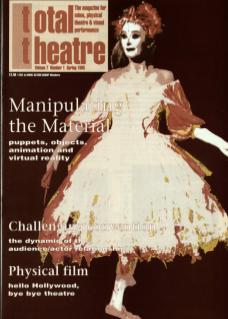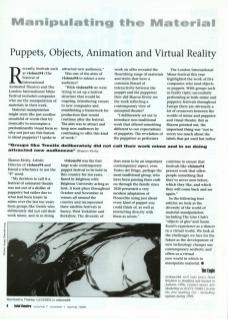Material manipulation might seem like just another mouthful of words that try ironically to encompass a predominantly visual form, so why not just say this feature is about puppetry? I spoke to groups like Trestle’s Sharon Kivity, Artistic Director of visions94, and found a reluctance to use the ‘P’ word.
‘My decision to call it a festival of animated theatre was not out of a dislike of puppetry but rather due to what had been learnt in mime over the last ten years from groups like Trestle who deliberately did not call their work mime, and in so doing attracted new audiences.’
Was one of the aims of visions94 to attract a new audience?
‘With visions94 we were trying to set up a festival structure that would be ongoing, introducing venues to new companies and establishing a framework for production that would continue after the festival. The aim was to attract and keep new audiences by continuing to offer this kind of work.’
Visions94 was the first large-scale contemporary puppet festival to be held in this country for ten years. Based in Brighton with Brighton University acting as host, it took place throughout October and November in venues all around the country and incorporated three satellite festivals in Surrey, West Yorkshire and Berkshire. The diversity of work on offer revealed the flourishing range of materials and styles that have a common thread of interactivity between the puppet and the puppeteer. How did Sharon Kivity see the work reflecting a contemporary view of animated theatre?
‘I deliberately set out to introduce non-traditional work that offered something different to our expectations of puppetry. The revelation of the puppeteer as performer does seem to be an important contemporary aspect, even Teatro del Drago, perhaps the most traditional group, who have been passing their craft on through the family since 1820 presented a very modern adaptation of Pinnochio using just about every kind of puppet you could think of, as well as interacting directly with them as actors.’
The London International Mime Festival this year highlighted the work of five companies who used objects or puppets. With groups such as Faulty Optic successfully performing at both mime and puppetry festivals throughout Europe there are obviously a lot of crossovers between the worlds of mime and puppetry and visual theatre. But as Sharon pointed out, the important thing was ‘not to worry too much about the labels that get used but rather continue to ensure that festivals like visions94 present work that offers people something that they've never seen before, which they like, and which they will come back and see again’.
In the following four articles we look at the diversity of the world of material manipulation, including The Glee Club's ‘objects of glee’ and Susan Kozel's experience as a dancer in a virtual world. We look at the challenges we face for the future as the development of new technology changes our contemporary aesthetic and offers us a virtual new world in which to manipulate material.
Visions 96 will take place from Brighton to Bradford and beyond in autumn 1996.

